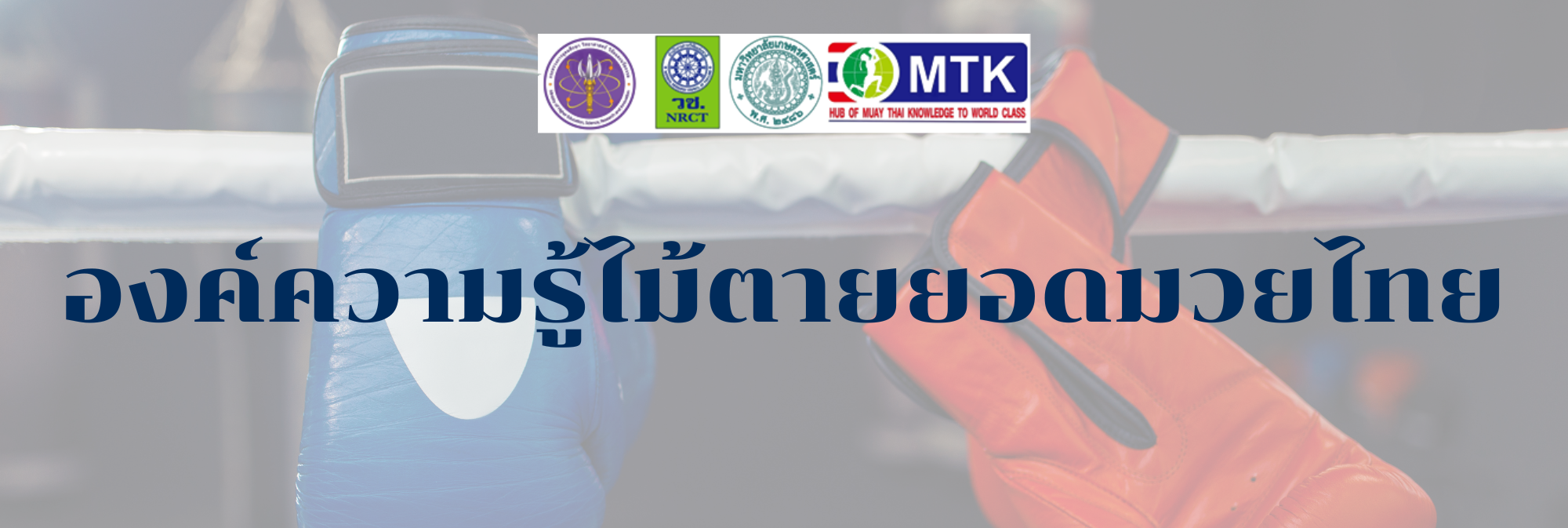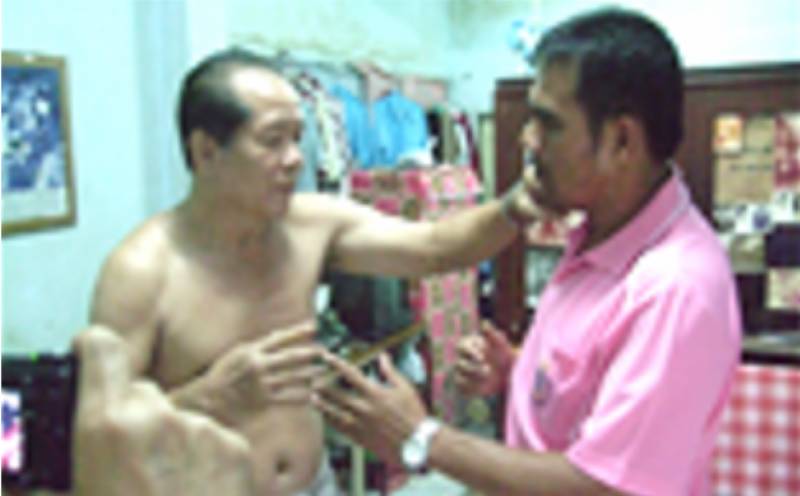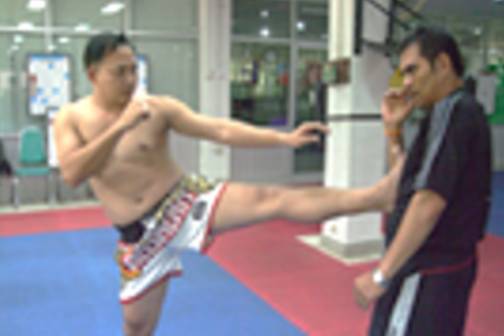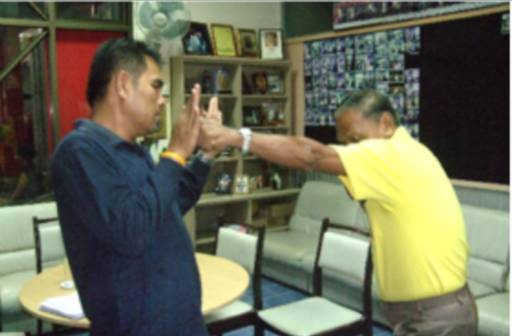
องค์ความรู้มวยไทย ยอดไม้ตายมวยไทย ในมหกรรมศิลปะมวยไทย “Amazing Muay Thai Festival 2024”
นักมวยที่ดี กีฬามวยนี้กับความมั่นคงและความก้าวหน้าของประเทศชาติก็สัมพันธ์กันอย่างใกล้ชิด เพราะว่ามวยนี้เป็นการป้องกันตัวด้วยการใช้การต่อสู้ส่วนหนึ่งและด้วยวิธีที่จะพัฒนาประเทศอีกส่วนหนึ่งนักมวยทราบดีว่าถ้าต่อสู้เฉพาะด้วยกำลังคงแพ้แน่ต้องมีวิชาการวิธีการ อละต้องมีสติที่มั่นคง ที่รู้วิชาการ ที่จะบุกและวิชาการที่จะหลบ ฉะนั้นการที่มีการต่อสู้มวย เพื่อป้องกันตัวก็ต้องอาศัยสองอย่างเหมือนกันพระราชดำรัสของพระบาทสมเด็จพระเจ้าอยู่หัวภูมิพลอดุลยเดช ไม้ตาย/ไม้เด็ดมวยไทย การนำเอาศิลปะมวยไทย ไม่ว่าจะเป็นหมัด เตะ ถีบ เข่า และศอก สมัยก่อนใช้แม้กระทั่ง หัว ทำให้คู่ต่อสู้ได้รับบาดเจ็บ อย่างรุนแรง หรือทำให้คู่ต่อสู้น็อคหรือหมดสติไป การใช้หมัด เท้า เข่า และศอก เป็นอาวุธหลัก อาวุธและความสามารถของแต่ละคนไม่เหมือนกัน ไม้ตายก็คือไม้น็อค เป็นไม้มวยที่ใช้ออกไปแล้วคู่ต่อสู้แก้ไขไม่ได้ การแก้ไขไม่ได้คืออยู่ในลักษณะ ที่เรียกตามภาษาคู่ต่อสู้ตกอยู่ภายใต้ลักษณะบังคับ ไม้ตาย หมายถึงไม้มวยที่ใช้ไปแล้วคู่ต่อสู้น็อค การใช้อาวุธ ทักษะการใช้หมัด การใช้เท้า การใช้เข่า การใช้ศอกที่ตัวเองมีความถนัด ในท่าที่มีความหนักหน่วงเมื่อโดนเข้าไปแล้ว คู่ต่อสู้ป้องกันยากหรือแก้ไขได้ยากและได้รับความบอบช้ำหรืออันตรายที่รุนแรง
สรุปไม้ตาย หมายถึง อาวุธมวยไทย ได้แก่ หมัด เท้า เข่าหรือศอก ที่นักมวยใช้ออกไปแล้วทำให้คู่ต่อสู้ ไม่สามารถทำการต่อสู้ได้อีก เช่น ได้รับบาดเจ็บหนัก หมดสติหรือถูกน็อค
วิธีการคิดไม้ตายสมัยโบราณ
มักวางแผนเกมการต่อสู้ คุณใช้ไม้ตายแบบนี้ต้องหลบแบบนี้ ล่อหลอกให้คู่ต่อสู้ออกอาวุธให้เข้าสู้ ท่าไม้ตาย สมัยโบราณนักมวยชกกันบนเวที ครูมวยจะนั่งดูแล้วคอยแก้ท่ามวย เท่ากับการต่อวิชาระหว่างครูกับครู ทำให้วิชาก้าวไกล “เวลานักมวยต่อยกัน เหมือนครูมวยต่อยกันด้วย”
วิธีการฝึกไม้ตายสมัยโบราณ
“การไล่ลูกไม้” ให้ฝ่ายหนึ่งเป็นฝ่ายรุก ฝ่ายหนึ่งเป็นฝ่ายรับ ฝึกช้าๆแล้วเพิ่มความเร็ว “การประลองเชิง”การต่อสู้เน้นจังหวะ/เวลา/สรีระ/ที่เป็นจุดอ่อน/อยู่ในลักษณะ บังคับฝึกโดยการทำซ้ำจนเกิดความเคยชินจนเป็นอัตโนมัติ ลักษณะบังคับคือ การกระทำใดๆออกไปแล้ว คู่ต่อสู้จะโต้
ตอบหรือไม่โต้ตอบก็ไม่สามารถแก้ไขความสูญเสียได้
การฝึกไม้ตายสมัยปัจจุบัน
ปัจจุบันต้องอาศัยพื้นฐานทางพละกำลังฟิตเนส หลักทางวิทยาศาสตร์ การกิน การใช้พลังงาน การสะสมพลังงาน ปัจจุบันคนที่ชนะต้องมีพละกำลัง คนที่มีฝีมือ ทำเกือบตายแต่เขาทำทีเดียวแพ้”ไม้ตายคือเรื่องของพละกำลัง”การหักให้ล้มการตีการจับการล็อคให้มีอาการหรือการทรงตัวสำคัญมากสมัยนี้มีเครื่องมือและอุปกรณ์ค่ายมวยให้นักมวยเตกระสอบ เตะเป้าและใช้เครื่องมือทางวิทยาศาสตร์ออกกำลังกาย ฝึกคู่กับฝึกปล้ำ
กลุ่มตัวอย่างที่ศึกษา
กลุ่มที่ 1 นักมวยถ้วยรางวัลพระราชทาน จำนวน 7 คน ได้แก่ นำศักดิ์ ยนตรกิจ, เฉลิมศักดิ์ เพลินจิต, ศรนักรบ เกียรติวายุภักดิ์, เดชฤทธิ์ อิทธิอนุชิต, สมพงษ์ เจริญเมือง, เผด็จศึก พิษณุราชันย์ และอนุวัฒน์ แก้วสัมฤทธิ์
เสียชีวิตไปแล้ว 3 คน ได้แก่ นำศักดิ์ ยนตรกิจ, เฉลิมศักดิ์ เพลินจิต และศรนักรบ เกียรติวายุภักดิ์ นักมวยถ้วยรางวัลพระราชทานที่ยังมีชีวิตอยู่ จำนวน 3 คน
กลุ่มที่ 2 นักมวยที่ได้รับการยกย่องจากคณะกรรมการของเวทีมวยราชดำเนิน ปี 2527 จำนวน 10 คน ได้แก่ ผล พระประแดง, สุข ประสาทหินพิมาย, ชูชัย พระขรรค์ชัย, ประยุทธ์ อุดมศักดิ์, อดุลย์ ศรีโสธร, อภิเดช ศิษย์หิรัญ, วิชาญน้อย พรทวี, พุฒ ล้อเหล็ก, ผุดผาดน้อย วรวุฒิ และดีเซลน้อย ช.ธนสุกาญจน์ เสียชีวิตไปแล้ว 5 คน ได้แก่ ผล พระประแดง, สุข ปราสาทหินพิมาย, ชูชัย พระขรรค์ชัย, ประยุทธ์ อุดมศักดิ์ และอดุลย์ ศรีโสธร
กลุ่มที่ 3 นักมวยที่ได้รับการยกย่องจากสมาคมผู้สื่อข่าวกีฬาแห่งประเทศไทย และการกีฬาแห่งประเทศไทย นักมวยที่ได้รับการยกย่อง จากสมาคมผู้สื่อข่าวกีฬาแห่งประเทศไทย การกีฬา แห่งประเทศไทย ตั้งแต่ พ.ศ. 2546-2552 และแชมเปี้ยนเวทีมวยราชดำเนิน และเวทีมวยลุมพินี จำนวน 56 คน
3. ทักษะพื้นฐานและไม้มวย
เดชฤทธิ์ อิทธิอนุชิต (เกิด พ.ศ.2483) นักมวยถ้วยรางวัลพระราชทาน คนที่ 2 ปี พ.ศ.2506
ที่มาของไม้ตายหมัด ได้รับการสอนจากครูเขตร ศรียาภัย
วิธีการฝึก ชกกระสอบ เล่นลูกเหล็ก และชกลม
วิธีการใช้ จะใช้หมัดขว้างสั้นในจังหวะที่คู่ต่อสู้เปิด จังหวะสวนที่คู่ต่อสู้ออกอาวุธหรือย่างสามขุมเข้าไปต่อย เป้าหมายที่หน้าท้องและใบหน้า วิธีการต่อยต้องยืนเต็ม เท้าย่อเข่าลงส่งแรงจากขา และสะโพก
ถ่ายน้ำหนักตัวช่วยบิดหมัดต่ำลงไปที่เป้าหมายผู้ได้รับการถ่ายทอด คือ น้องชายฤทธิ์เดช สิงห์มรกต และผู้ที่มาเรียนหลักสูตรศิลปะการป้องกันตัวของกรมทหารบก
วิธีการถ่ายทอด สอนการย่างสามขุม การออกหมัด การฝึกเป็นชุด และใช้ลูกมะนาวเสริมสร้างความคล่องแคล่วว่องไวของข้อมือ
สมพงษ์ เจริญเมือง ฉายา “จอมบุก” (เกิด พ.ศ.2483)นักมวยถ้วยรางวัลพระราชทาน คนที่ 3 ปี พ.ศ.2508
ที่มาของไม้ตายหมัด ได้รับการสอนจากครูชาย รสพ. และครูมวยสนอง รสพ.
วิธีการฝึก ใช้สตางค์รูแขวนฝึกชกกระสอบและชกเป้า
วิธีการใช้ จะใช้หมัดเหวี่ยงสั้นในจังหวะที่คู่ต่อสู้มือตกหรือปัดหมัดแล้วก็ชกไปที่บริเวณท้องและปลายคาง วิธีการชกชกหมัดขวาก้าวเท้าขวาแบบมือต่อยศอกตั้งไว้ เวลาต่อยหมัดคว่ำ หมัดแล้วกำมือและจะออกอาวุธมวยไทย ผสมด้วยการต่อยเป็นชุด
ผู้ได้รับการถ่ายทอดเป็นนักมวยในค่ายของตนเองวิธีการถ่ายทอดสอน
ฝึกหมัดตรงซ้าย หมัดตรงขวา 1-2 แล้วก็ชกหมัดเหวี่ยงสั้น
เผด็จศึก พิษณุราชันย์ “ขุนศอกมีดโกน” (เกิดพ.ศ.2500)นักมวยถ้วยรางวัลพระราชทาน คนที่ 4 ปี พ.ศ.2522
ที่มาของไม้ตายศอก ได้จากปรากฎการณ์ธรรมชาติ คือ ฟ้าผ่า
วิธีการฝึก ฝึกตีกับกระสอบทราย
วิธีการใช้ ใช้จังหวะ 2 คู่ต่อสู้
จับคอเราเข่าเราก็หมุน ศอกเงื้อมาจากข้างบน เขย่งเท้ายกขาขวาขึ้นสูงกระตุกศอกจาก ข้างบนลงมาใช้แรงจากหัวไหล่ช่วย เวลาฟันให้กระตุกเหมือน ฉีกกระดาษ เหมือนงูฉก แล้วพับแขนลงมาให้กำปั้นมาตีหน้าอก ให้ศอกเฉียดบริเวณหัวคิ้ว ถ้าตีเต็มมันจะไม่แตกแต่โนเฉยๆโดยมีเป้าหมายที่หัวคิ้วผู้ได้รับการถ่ายทอดขณะนี้ยังไม่ได้ถ่ายทอดให้ใครวิธีการถ่ายทอด ฝึกตีกระสอบทราย ฝึกตีเป้าเล็กและฝึกเล่นลม
อนุวัฒน์ แก้วสัมฤทธิ์ ฉายา “เพชฌฆาตขนตางอน” (เกิด พ.ศ.2524) นักมวยถ้วยรางวัลพระราชทานคนที่ 7 ที่มาของไม้ตายหมัด ได้รับการสอนจากนายศรีเมือง สิงห์สวนเงิน หัวหน้าค่ายมวย แก้วสัมฤทธิ์
วิธีการฝึก ฝึกชกลมและใช้อุปกรณ์ช่วย เช่น ล่อเป้า และยกดรัมเบล
วิธีการใช้ จะใช้อาวุธนำโดยการเตะขา โดยคู่ต่อสู้เปิดก็ต่อยหมัด วิธี
การชกหมัดตรงใช้แรงจากหัวไหล่ และลำตัวช่วย และกดข้อมือลงเพื่อให้หมัดถูกเป้าหมายบริเวณท้องหมัดเหวี่ยงจะเหวี่ยงหมัดขึ้นสูง โดยใช้
หัวไหล่แล้วกดหมัดลงเป้าหมายคือกกหูส่วนหมัดงัดจะใช้ตัวและหัวไหล่บิดช่วยใช้แรงหมดทั้งตัว ผู้ได้รับการถ่ายทอด สอนนักมวยในค่ายแก้วสัมฤทธิ์ทุกคนที่สนใจ วิธีการถ่ายทอด อนการออกหมัดสบายๆ ไม่เกร็งโดยการออกหมัดแต่ละครั้งต้องเร็วคล้ายงูฉก
ภิเดช ศิษย์หิรัญ (เกิด พ.ศ.2484) ฉายา “จอมเตะบางนกแขวก” ลำดับที่ 6 ที่มาของไม้ตายเตะ ได้รับการสอนจากครูสุพร วงศาโรจน์
วิธีการฝึก ฝึกเตะต้นกล้วย และเตะฟุตบอล
วิธีการใช้ ใช้วิธีการโยกตัวหลบก่อนหรือเตะให้เขาบังความพิเศษของลูกเตะ คือ เตะเบิ้ล 2-3 ครั้ง ระยะใกล้จะใช้หน้าแข้ง ถ้าระยะไกลจะใช้หลังเท้า เป้าหมายการเตะบริเวณหน้าท้องผู้ได้รับการถ่ายทอด ผู้ได้รับการถ่ายทอดเป็นทั้งคนไทยและคนต่างชาติวิธีการถ่ายทอด สอนการฝึกเตะฟุตบอล และฝึกเตะกระสอบทราย
วิชาญน้อย พรทวี (เกิด พ.ศ.2491) ฉายา “ยอดมวยอมตะ” ลำดับที่ 7
ที่มาของไม้ตายหมัด จากการเปลี่ยนแปลงของรูปร่างที่มีรูปร่างเตี้ย
ลดน้ำหนักไม่ได้
วิธีการฝึก ฝึกวิธีการยืนและการเคลื่อนที่
วิธีการใช้ จะใช้วิธีการเข้าไปเตะขาให้คู่ต่อสู้เสียจังหวะล่อให้คู่ต่อสู้เข้ามา ถ้าเจอมวยหนีใช้วิธีการเดินขวางมวย และเตะตัดขาเพื่อหยุดอาวุธยาว แล้วต่อยหมัดตรงโดยส่งน้ำหนัก ออกจากหัวไหล่ เท้าหน้ารับน้ำหนักไว้
ผู้ได้รับการถ่ายทอด โรจน์เดช โรจน์สงคราม วิธีการถ่ายทอด สอนการยืนการเคลื่อนที่ การเดินไปฝึกต่อยคู่ต่อสู้ และฝึกความแข็งแรงของร่างกาย โดยใช้น้ำหนัก
พุฒ ล้อเหล็ก (เกิด พ.ศ.2495) ฉายา “ไอ้หนูเมืองตรัง”ลำดับที่ 8
ที่มาของไม้ตายเตะ ได้รับการสอนจากครูสวัสดิ์ แสงสุวรรณ และน้าชาย กิ่งแก้ว บางยี่ขัน
วิธีการฝึก ฝึกการกระโดดให้ตัวลอย และฝึกเตะกระสอบทราย
วิธีการใช้ จะใช้ในจังหวะที่คู่ต่อสู้เผลอหรือใช้มือปัดมือคู่ต่อสู้ให้ห้อยลง แล้วเตะก้านคอด้วยเท้าซ้าย ในขณะเตะลำตัวจะเอียงไปทางด้านขวา
เท้าซ้ายยกสูงใช้ไหล่และสะโพกช่วยออกแรง ผู้ได้รับการถ่ายทอด ผู้ได้รับการถ่ายทอดรุ่งศิรินักมวยในค่ายที่เปิดสอนคนไทยและคนต่าประเทศ
วิธีการถ่ายทอด สอนฝึกทักษะพื้นฐานและฝึกเตะกระสอบทราย
ดีเซลน้อย ช.ธนสุกาญจน์ (เกิด พ.ศ.2504) ฉายา “ขุนเข่าทะลุฟ้า” ลำดับที่ 10 ที่มาของไม้ตายเข่า เป็นความถนัดและรูปร่างสูง
วิธีการฝึก ฝึกเข่ากระสอบ ตีเข่ากับเป้า และเล่นลม
วิธีการใช้ จะใช้อาวุธนำก่อน เช่น การต่อยนำหรือเตะซ้าย แล้วดูจังหวะที่สามารถโยนเข่าได้หรือ ใช้มือค้ำแล้ว แทงเข่าบริเวณลำตัว ลิ้นปี่และท้อง เทคนิคการเข่า พอแทงเข่าแล้วคู่ต่อสู้สะดุ้ง จะแทงยาวโดยเอวจะต้องดันแล้วส่งขึ้นปลายเท้างุ้มลงผู้ได้รับการถ่ายทอด พนมทวนเล็ก ฉมวกเพชร
วิธีการถ่ายทอด ฝึกสมรรถภาพทางกาย ฝึกเล่นลม ฝึกกับอุปกรณ์
และฝึกกับคู่
แสนชัย ส.คิงสตาร์ (เกิด พ.ศ.2523) ฉายา “โคตรมวยสารคาม” นักชกยอดเยี่ยม 5 รางวัลที่มาของไม้ตายเตะ จากประสบการณ์ในการชกมวย และคิดดัดแปลงเทคนิคการชกมวย
วิธีการฝึก ฝึกแบบแยกส่วน และฝึกรวมส่วน ฝึกจากช้าไปหาเร็ว
วิธีการใช้ จะเตะขาคู่ต่อสู้จนกว่าคู่ต่อสู้จะบังพอบังขาก็พลิกขาไปเตะก้านคอหรือปลายคางผู้ได้รับการถ่ายทอด เป็นลูกศิษย์ 4-5 คน ที่ซ้อมมวยในค่ายเดียวกัน
วิธีการถ่ายทอด สอนเตะต่ำ เตะสูง โดยใช้เป้าและสอนเตะขาวก เตะก้านคอ
แสนชัย ส.คิงสตาร์ (เกิด พ.ศ.2523) ฉายา “โคตรมวยสารคาม” นักชกยอดเยี่ยม 5 รางวัลที่มาของไม้ตายถีบ จากประสบการณ์ และคิดดัดแปลง เทคนิควิธีการถีบ เตะบิดถีบ
วิธีการฝึก ฝึกแบบแยกส่วนและรวมส่วน
วิธีการใช้ ใช้ในจังหวะที่ต่างคนต่างรุกและจังหวะที่คู่ต่อสู้รุกเข้ามา หรือจังหวะบวกวิธีการเตะลำตัวให้เร็วเมื่อคู่ต่อสู้คิดว่าเราจะเตะแต่เราบิดถีบ คือ หลอกกลางคันที่บริเวณท้องและหน้าอก ผู้ได้รับการถ่ายทอด เป็นลูกศิษย์ที่อยู่ในค่ายมวยเดียวกัน 3-4 คน
วิธีการถ่ายทอด ฝึกทักษะการยืนถีบยืนเตะ ฝึกเตะเป้าและถีบเป้า
บัวขาว ป.ประมุข (เกิด พ.ศ.2525) ฉายา “ดำทมิฬ” หรือ “ดำดอทคอม”แชมป์เปี้ยนมวยไทย/แชมป์K-1ที่มาของไม้ตายศอกจาเทรนเนอร์และผู้จัดการ
วิธีการฝึก ฝึกศอกกับเป้า ฝึกศอกกับกระสอบทราย และฝึกเล่นลม
วิธีการใช้ จะใช้ในจังหวะประชิดตัว หรืออยู่ใกล้คู่ต่อสู้ และจังหวะที่คู่ต่อสู้เผลอโดยจะตีที่บริเวณใต้คาง เพราะเวลาตีจากข้างบน คู่ต่อสู้จะก้มหน้าลงจะพ้นแต่ถ้าไม่พ้นจะถูกช่วงกราม ถ้าพ้นจะถูกคิ้ว วิธีการตี จะตีเฉียดนิดหนึ่ง ใช้แรงจากขา เอวช่วยบิดใช้ไหล่และแขนกระชากลงมาผู้ได้รับการถ่ายทอด เป็นเด็กๆ และน้องๆ ที่ซ้อมอยู่ในค่ายมวย ป.ประมุขวิธีการถ่ายทอด ฝึกพื้นฐานและตีกับกระสอบทรายเที่มาของไม้ตายเตะ พ่อเป็นคนสอนให้และดูการชกมวยของนักมวยรุ่นพี่สามารถ พยัคฆ์อรุณ
วิธีการฝึก ฝึกเตะกระสอบ และฝึกเตะเป้าคู่หน้า
วิธีการใช้ วิธีการเตะจะใช้วิธีการโยกตัวหลอก โดยการทำท่าเตะขา แต่เตะลำตัวและใช้จังหวะที่คู่ต่อสู้เตะมาบังหรือเตะพลาด ใช้จังหวะสอง วิธีการเตะจะใช้จากส้นเท้า สะโพก แขน ช่วยในการเคลื่อนไหวและความเร็ว การเตะจะเตะเป็นชุด โดยมีเป้าหมายที่ลำตัวผู้ได้รับการถ่ายทอด เป็นลูกศิษย์ ที่เรียนในค่ายมวยประเทศสหรัฐอเมริกา
วิธีการถ่ายทอด สอนการก้าวเท้า และเทคนิคการเตะมธี เจดีย์พิทักษ์ (เกิด พ.ศ.2515) ฉายา “แข้งมังกร” แชมป์เปี้ยนมวยไทยเข็มขัด 2 เส้น
ชาญชัย ส.ธรรมรังสี (เกิด พ.ศ.2510) ฉายา “พุฒ 2” แชมป์เปี้ยนมวยไทยเข็มขัด5เส้นที่มาของไม้ตายถีบ จากการดูนักมวยรุ่นเก่าชกมวยที่เวทีมวยราชดำเนิน
วิธีการฝึก ฝึกถีบเสาบ้าน และฝึกถีบกระสอบ
วิธีการใช้ จะใช้ถีบสกัดในจังหวะที่คู่ต่อสู้เข้ามาต่อย ในจังหวะรุกจะใช้ถีบบน ถีบล่าง ถีบหน้า ถีบหลังสลับกันไปโดยถีบ บริเวณหน้าท้องวิธีการถีบมี 2 วิธี คือ ถีบให้ช้ำ คือ ถีบเบาบ้าง หนักบ้าง โดยใช้อุ้งเท้าและวิธีที่ 2 ถีบกระเพาะปัสสาวะ โดยใช้หัวแม่โป้งเท้าจิ้มเข้าไปโถมหน้า และถ่ายน้ำหนักตัวไปข้างหน้าผู้ได้รับการถ่ายทอด ยังไม่ได้ถ่ายทอดให้ใคร
วิธีการถ่ายทอด วิธีสอนให้ปฏิบัติทีละขั้นตอน เน้นพิเศษ คือ ถีบเยอะ ๆ
ราวี เดชาชัย (เกิด พ.ศ.2485) ฉายา “จรวดทัพฟ้า” แชมป์เปี้ยนมิดเดิลเวท เวทีราชดำเนินที่มาของไม้ตายศอก ได้จากประสบการณ์ในการชกมวย
วิธีการฝึก ฝึกเล่นลม และฝึกตีกระสอบทราย
วิธีการใช้ เดินเข้าไปหาคู่ต่อสู้แล้วใช้อาวุธเช่น การชกหมัดแล้วใช้มือเหยียดออกปิดตาคู่ต่อสู้แล้วฟันศอก มีวิธีการดังนี้ เหยียดมือข้างใด ข้างหนึ่งหรือสองมือ โดยเหยียดแขนออกไปปิดตาคู่ต่อสู้ แล้วฟันศอก ใช้แรงโถมและบิดทั้งตัว ในการฟันจะฟันเป็นชุด เมื่อฟันศอกแล้วก็จะมีการกระตุกศอกกลับอีกครั้งหนึ่ง โดยมีเป้าหมายการฟันศอกบริเวณใบหน้าผู้ได้รับการถ่ายทอด ขณะนี้ยังไม่ได้ถ่ายทอดให้ใคร
วิธีการถ่ายทอด สอนทักษะพื้นฐานมวยให้คล่องก่อน แล้วสอนปิดตาคู่ต่อสู้ฟันศอก โดยฝึกชกลมผสมศอกและฝึกกับกระสอบทราย
สำราญเดช ม.ราชภัฏฯ จอมบึง (เกิด พ.ศ.2526) ฉายา “จอมหักพวงมาลัย” แชมป์เปี้ยนมวยไทยเข็มขัด 3 เส้นที่มาของไม้ตายถีบ จากประสบการณ์ ในการชกมวย
วิธีการฝึก ฝึกถีบกระสอบทรายและเสาปูนที่อยู่ในค่ายมวย
วิธีการใช้ ใช้ในจังหวะที่คู่ต่อสู้เผลอ ถ้าถีบด้วยเท้าขวาปลายเท้าซ้ายจะชี้ไป ด้านหลัง 45 องศา ใช้ฝ่าเท้าขวายกเท้าบิดหมุนออกถีบตรงไปที่หน้าท้อง โดยการยืนหรือกระโดด ถ้ากระโดดจะมีความรุนแรงหรือขวาเหยียดขนานขาที่ถีบ ส่วนแขน ซ้ายป้องกันไว้ที่คางผู้ได้รับการถ่ายทอด เป็นลูกศิษย์ที่อยู่ในค่ายมวยเดียวกัน ตอนนี้ประมาณ 3 คน
วิธีการถ่ายทอด สอนจดมวย สอนถีบข้าง ฝึกจากช้าไปหาเร็ว ฝึกถีบกระสอบทรายและฝึกเล่นเชิงโดยใส่เครื่องป้องกันตัว
ศุภชัย สารคาม (เกิด พ.ศ.2475) ฉายา “ไอ้หนูดำปืน” แชมป์เปี้ยนมวยไทยและมวยสากลที่มาของไม้ตายถีบ ได้รับการสอนจากครูจะเด็จ
วิธีการฝึก ฝึกลีลาหมัดฝึกชกใบมะยม
วิธีการใช้ จะใช้การสเต็ปเท้าเข้าไปหาคู่ต่อสู้แล้วชกหมัดเย็บเป้าหมาย ใช้สันหมัดถูกปลายคางคู่ต่อสู้ วิธีชกหมัดออกไปแขนกับไหล่เป็นเส้นตรงเหมือนแท่งสากกะเบือโล้ตัวไปข้างหน้า เพื่อส่งแรงทำด้วยความรวดเร็วผู้ได้รับการถ่ายทอด คุณอำนวย เกษบำรุง ผู้อำนวยการโรงเรียนมวยไทยรังสิตวิธีการถ่ายทอด สอนวิธีการสปริงเท้าเข้าออกและสอนการออกหมัดในจังหวะที่เท้าตกพื้น
อนันตศักดิ์ รฟท. (เกิด พ.ศ.2485) ฉายา “ขุนเข่าม้าเหล็ก” แชมป์เปี้ยนมวยไทย 2 รุ่น ที่มาของไม้ตายถีบ ได้จากการดูนักมวยเข่า
วิธีการฝึก ฝึกตีกระสอบทราย ฝึกปล้ำเข่า ดึงเสาบ้านเพิ่มความแข็งแรง
วิธีการใช้ จะใช้อาวุธนำก่อนเช่นถีบนำ เพื่อให้คู่ต่อสู้เสียหลักแล้วเข้าไปจับตีหรือในจังหวะที่คู่ต่อสู้ ต่อยหมัดหลบนิดหนึ่งแล้วสวนเข้าไปด้วยเข่าที่ชายโครงผู้ได้รับการถ่ายทอด เป็นนักมวยที่มาเรียนในค่ายมวย
วิธีการถ่ายทอด ฝึกจับตีกระสอบทรายเบี่ยงตีและกระโดดตีเข่า
โอโรโน่ พ.เมืองอุบล (เกิด พ.ศ.2516) ฉายา “ขุนเข่าเสียงสวรรค์” แชมป์เวทีมวยลุมพินี นักชกยอดเยี่ยม 2537
ที่มาของไม้ตายถีบ ต้องการเอาชนะคำสบประมาท
วิธีการฝึก ฝึกปล้ำกับคู่ และฝึกตีกระสอบ
วิธีการใช้ จะใช้การถีบนำและเตะนำก่อน แล้วเข้าไปเกาะตีแลกกัน วิธีการตีเข่าแบบโหนตีจะดึงคู่ต่อสู้ลงมาโดยการกระตุกแขน แล้วโหนตี ขึ้นไปเหมือนฟาดตะกร้อเป้าหมายการตีที่บริเวณลำตัวผู้ได้รับการถ่ายทอด คนไทยและคนต่างประเทศ
วิธีการถ่ายทอด ฝึกจับคอ จับดึง จับกระตุก หัดฝึกตี ตีกระสอบและปล้ำคู่
จัดทำโดยศูนย์กลางความรู้ศิลปะมวยไทยสู่ระดับโลก
“ได้รับทุนอุดหนุนการทํากิจกรรมส่งเสริมและสนับสนุนการวิจัยและนวัตกรรมจากสํานักงานการวิจัยแห่งชาติ”




Muay Thai Knowledge: Signature Techniques and “Kray Mai Tai” in the Amazing Muay Thai Festival 2024
The Concept of a “Deadly Technique” in Muay Thai and the Role of a Skilled Boxer
A proficient Muay Thai practitioner understands that the sport is closely linked to both national security and the advancement of the country. Boxing is not merely a means of physical confrontation; it is also a disciplined system for self-defense and personal development, which in turn contributes to societal stability. A boxer knows that relying solely on brute force is insufficient; one must also possess technical knowledge, tactical awareness, and mental composure. Effective fighting requires mastery of both offensive techniques (“techniques to strike”) and defensive strategies (“techniques to evade”), reflecting the dual necessity of skill and mindfulness in self-defense. This concept aligns with the royal discourse of His Majesty King Bhumibol Adulyadej, emphasizing the inseparable relationship between martial arts training and broader societal development.
In Muay Thai, a “deadly technique” (Mai Tai) refers to a decisive strike or maneuver designed to incapacitate an opponent, making it impossible for them to continue fighting. Traditionally, Muay Thai utilizes a combination of punches (chok), kicks (teep/tae), knees (kao), and elbows (sok), and historically even included strikes with the head. Each weapon and skill is unique to the practitioner, and the “Mai Tai” is a technique delivered with such precision and force that the opponent cannot effectively defend or counter it.
In summary, a “Mai Tai” in Muay Thai is a lethal application of the body’s primary striking tools—fists, feet, knees, or elbows—executed in a manner that incapacitates the opponent, resulting in severe injury, loss of consciousness, or a knockout (KO). It represents the ultimate synthesis of technique, power, and timing in the art of Muay Thai.
The Traditional and Contemporary Approaches to Developing “Deadly Techniques” in Muay Thai
Ancient Conceptualization of “Deadly Techniques”
Historically, Muay Thai fighters meticulously planned their combat strategies. The application of a “Mai Tai” (deadly technique) was coordinated with specific defensive actions, often using feints to lure the opponent into delivering attacks that could be countered effectively. In traditional practice, bouts took place in the ring while the kru muay (boxing master) observed from the sidelines, adjusting and refining techniques as the fight progressed. This dynamic was akin to a master-to-master exchange of knowledge, reflecting the idea that “when fighters strike, it is as if the masters themselves are exchanging blows.”
Ancient Training Methods
- Chasing the Techniques (Lai Luk Mai) – One fighter assumes the offensive role, the other defensive, starting slowly and gradually increasing speed.
- Tactical Sparring (Pralong Chieng) – Focuses on timing, physiology, and exploiting the opponent’s weak points. Repetition ingrains responses, creating automatic reflexes. A technique is considered effective if, once executed, the opponent cannot neutralize its impact, regardless of whether they attempt a counter.
Contemporary Training Methods
Modern Muay Thai emphasizes physical fitness, biomechanics, energy management, and scientific principles. Success depends not only on skill but also on physical power and endurance. While a highly skilled fighter may execute complex techniques, victory often hinges on strength and precision. Today, training incorporates scientific equipment, including heavy bags, kicking pads, and strength-conditioning tools, alongside traditional sparring and clinch practice, ensuring both offensive and defensive mastery.
Sample Population Studied
- Royal Trophy Boxers (7 individuals) – Namsak Yontarakit, Chalermsak Ploenchit, Sorn Nakrob Kiatiwayuphak, Detrit Itthionuchit, Sompong Charoenmuang, Phedchuek Phitsanurachan, Anuwat Kaewsamut. (Three deceased: Namsak Yontarakit, Chalermsak Ploenchit, Sorn Nakrob Kiatiwayuphak)
- Rajadamnern Stadium Recognized Boxers (10 individuals, 1984) – Phon Phrapradang, Suk Prasart Hin Phimai, Chuchai Prakhankchai, Prayut Udomsak, Adul Srisothorn, Apidet Sit Hirun, Wichan Noi Pornthawi, Phut Lolek, Phutphad Noi Worawut, Diesel Noi Ch. Thanasukarn. (Five deceased: Phon Phrapradang, Suk Prasart Hin Phimai, Chuchai Prakhankchai, Prayut Udomsak, Adul Srisothorn)
- Boxers Recognized by Thai Sports Journalists Association and the Sports Authority of Thailand (2003–2009) – 56 champions from Rajadamnern and Lumpinee Stadiums.
Basic Skills and “Mai” Techniques
Example: Detrit Itthionuchit (b. 1940), a Royal Trophy boxer in 1963, learned the punch Mai Tai from Kru Khet Sriyaphai. His training included heavy bag work, iron ball drills, and shadowboxing.
- Technique Application:
- Short, rapid punches delivered in response to an opening in the opponent’s guard.
- Counter-strikes timed to the opponent’s attack or “Yang Sam Khum” (forward step-in).
- Targets: abdomen and face.
- Execution requires full stance, knees bent for leg and hip power, and body rotation to transfer force.
- Transmission of Knowledge:
- Students included younger brother Rittidet Singmorakot and participants in the Army Department’s self-defense program.
- Training emphasized “Yang Sam Khum” stepping, punching sequences, and using small tools like lemons to enhance wrist agility and speed.
Profiles of Notable Fighters — Techniques, Training, and Transmission
1. Sompong Charoenmuang — “The Relentless Attacker” (b. 1940)
Title: Royal Trophy Boxer (3rd recipient, 1965)
Origin of Signature Punch: Learned from Kru Chai (Rosp.) and Kru Muay Sanong (Rosp.).
Training Methods: Heavy-bag work using a hanging money-bag (satang-ru) and pad work.
Application: Employs a short, arcing punch timed to when the opponent’s hand drops or after a parry; strikes directed to the abdomen and chin. Typical sequence: step forward with the right foot while keeping the elbow high, deliver a downward-angled punch (often a turning/downward fist), clench and follow with Muay Thai combinations.
Transmission: Taught fighters within his own gym.
Teaching Progression: Drills include straight left and right punches (1–2), followed by the short arcing punch.
2. Phedchuek Phitsanurachan — “The Razor Elbow” (b. 1957)
Title: Royal Trophy Boxer (4th recipient, 1979)
Origin of Signature Elbow: Inspired by a natural phenomenon — a lightning strike (metaphorical origin).
Training Methods: Heavy-bag elbow drills and pad work.
Application: Works in close two-person scenarios. When clinched, rotate the torso and drive an elbow from above. The supporting foot rises onto the ball and the right leg tugs the body, delivering the elbow downward using shoulder drive. Execution likened to tearing paper or a snake strike — snap the elbow then fold the arm so the fist strikes the chest while the elbow grazes the supraorbital area (targeting the brow ridge). Intention is to catch the opponent’s brow area (not necessarily to break bone but to stun/disable).
Transmission: As of report, has not formally passed the technique to a named successor.
Teaching Methods: Heavy-bag striking, small-target pad drills, and shadow sparring (chok lom).
3. Anuwat Kaewsamut — “The Lash-Lashed Executioner” (b. 1981)
Title: Royal Trophy Boxer (7th recipient)
Origin of Signature Punch: Trained by Mr. Sri Muang Sing Suan Ngern, head of the Kaewsamut camp.
Training Methods: Shadowboxing (chok lom), target drills (pad holding), and strength work (dumbbell lifts).
Application: Often sets up strikes with a leg kick; when the opponent opens, follows with punches. Straight punches are driven by shoulder and torso rotation with wrist press-down to hit the midsection. The arcing (swing) punch is thrown high using the shoulder then driven down onto the target (behind the ear / jawline). Uppercuts/levering punches utilize full-body torque and shoulder rotation.
Transmission: Teaches all interested fighters at Kaewsamut gym.
Coaching Notes: Emphasizes relaxed, rapid punching—snapping like a snake strike.
4. Phidetch Sit Hiran — “The Devastating Kicker of Bang Nok Kwaek” (b. 1941)
Order: 6th notable fighter in dataset
Origin of Signature Kick: Trained by Kru Suphon Wongsaroj.
Training Methods: Kicking banana trunks and ball/kick-football training.
Application: Uses feints and body sway to disguise the kick, often employing double kicks (two to three rapid repetitions). At close range uses the shin (front of the leg); at long range uses the instep. Primary target is the abdomen.
Transmission: Has taught both Thai and foreign students.
Teaching Methods: Football-style kicking drills and heavy-bag kicking.
5. Wichan Noi Pornthawi (Vichan Noi Pornthawi?) — “The Immortal Boxer” (b. 1948)
Order: 7th notable fighter
Origin of Signature Punch: Developed due to body morphology — shorter stature and difficulty cutting weight.
Training Methods: Stance and footwork drills.
Application: Uses leg kicks to disrupt opponent rhythm, lures opponent in, then employs cutting steps or oblique movement and low-leg checks; cuts the opponent’s base and follows with straight punches delivered with weight transfer from the shoulder (front foot holds weight). If opponent circles, uses lateral stepping to intercept and cuts the leg to stop long weapons, then dispatches straight punches with full weight.
Transmission: Taught to Rondej Rondsangram.
Coaching Methods: Emphasis on stance, footwork, partner sparring, and strength conditioning with weights.
6. Phut Lo Lek — “The Kid from Trang” (b. 1952)
Order: 8th notable fighter
Origin of Signature Kick: Trained by Kru Sawat Saengsuwan and uncle Kingkaew (Khingkaew) Bang Yikhan.
Training Methods: Plyometric jumping drills and heavy-bag kicking.
Application: Employed when the opponent is careless or has a dropped hand—parry the opponent’s hand to hang and then strike to the carotid / upper neck with the left foot. During execution, torso leans to the right; the left leg rises high using shoulder and hip drive.
Transmission: Passed to Rungsirin and other camp fighters (Thai and foreign students).
Teaching Methods: Fundamentals and heavy-bag kicking drills.
7. Diesel Noi Ch. Thanasukarn — “The Sky-Piercing Knee” (b. 1961)
Order: 10th notable fighter
Origin of Signature Knee: Derived from natural aptitude and tall stature.
Training Methods: Knee drills on bag, knee strikes against targets, clinch sparring.
Application: Sets up knees with preparatory strikes—lead jab or left kick to create openings—then finds timing for a knee toss or uses a hand frame to thrust the knee into the torso (solar plexus, epigastrium). Technique emphasizes hip drive: after planting the knee, extend through the waist and snap down with the toe flexed.
Transmission: Pnom Thuan Lek, Chamwokphet (students).
Teaching Methods: Conditioning, shadow clinch, equipment-assisted drills, and partner clinch practice.
8. Saenchai S. Kingstar — “The Ultimate Fighter of Sarakham” (b. 1980)
Accolades: Multiple “Fighter of the Year” awards (5)
Origin of Signature Kicks / Push-Kicks: Derived from in-ring experience and technical adaptation.
Training Methods: Isolated (segmental) drills and integrated (combined) drills, progressing from slow to fast.
Application (Kick): Persistently target the opponent’s leg until coverage occurs; when the leg is covered, pivot to attack the carotid or chin.
Transmission: Has 4–5 disciples from the same gym.
Coaching: Teaches low and high kicks using pads; focuses on leg-kick sequences and throat/neck targeting.
Origin of Signature Teep (Push-Kick / Pivotal Push): Also developed from experience and technique modification.
Training Methods: Segmental and integrated practice.
Application (Teep): Used both in mutual-clinch exchanges and when the opponent advances; executes rapid teep twists where feinting mid-action (appearing to teep to the body) and then rotating into a push that strikes the abdomen/chest.
Transmission: Taught to 3–4 gym teammates.
Coaching: Standing teep/standing kick mechanics; target drills and push-kick padwork.
Buakaw Por. Pramuk (บัวขาว ป.ประมุข) — nicknamed “Dam Tamim / DamDotCom” (born BE 2525 → 1982)
Titles: Muay Thai champion / K‑1 champion.
Origin of signature elbow (sok) technique: taught by his trainers and manager.
Training methods: elbow drills on pads; elbow work on heavy bag; shadow elbow practice (chok lom with elbows).
Application: used at very close range (in the clinch) or when an opponent is off‑guard. Targets are the sub‑mandibular region and jaw/brow area: an elbow delivered from above can catch the jaw or, if the opponent ducks, graze the brow. Execution: a short glancing elbow strike—drive through legs and hips, rotate the torso, pull the shoulder and arm sharply downwards.
Recipients of transmission: younger fighters training at the Por. Pramuk camp.
Method of transmission: fundamentals and repetitive heavy‑bag elbow work.
Samyaphak (“Siam P.??”) — (first block refers to a fighter named possibly พยัคฆ์อรุณ — text ambiguous)
Training methods: heavy‑bag kicking; front‑pad kicking.
Application: kicks employ feinting body motion (fake a leg kick but strike the body). Uses timing when the opponent blocks or misses a kick—often a two‑beat timing. Kicks are driven from the heel with hip and arm involvement for power and speed; executed in combinations aimed at the torso.
Recipients: students at the U.S. branch of the camp.
Transmission: teaches stepping and kicking techniques.
Mathee Chedipithak (มธี เจดีย์พิทักษ์) — “Dragon Shins” (born BE 2515 → 1972)
Titles: Two‑belt Muay Thai champion.
(No further detail provided in original excerpt beyond nickname and title.)
Chanchai S. Thammarangsi (ชาญชัย ส.ธรรมรังสี) — nicknamed “Phut 2” (born BE 2510 → 1967)
Titles: Muay Thai champion (five belts).
Origin of signature push/kick (teep) technique: inspired by watching senior fighters at Rajadamnern Stadium.
Training methods: plant‑pole teep drills and teep heavy‑bag work.
Application: uses teep to intercept incoming punches; in offense alternates high and low teeps (front, rear, push), often targeting the abdomen. Two teep variants described: (1) repeated teeps to cause bruising using the ball/sole of the foot (variable intensity), and (2) a precise teep aimed at the lower abdomen/urinary area using the big toe to penetrate and transfer forward body weight.
Transmission: not yet formally passed to a named successor.
Teaching method: stepwise instruction emphasizing high repetition of teeps.
Rawee Dechachai (ราวี เดชาชัย) — “Air Force Rocket” (born BE 2485 → 1942)
Title: Rajadamnern middleweight champion.
Origin of signature elbow (sok) technique: developed from in‑ring experience.
Training methods: shadow clinch and heavy‑bag elbow work.
Application: approach the opponent with punches then use an extended arm to obscure vision (hand cover) and fire the elbow—drive and rotate the whole body; deliver elbow in combinations and then retract (snap back). Targets: facial region.
Transmission: not yet formally assigned to a named successor.
Teaching method: consolidate basic skills first, then practice the blind‑cover‑and‑elbow sequence via shadow drills and heavy‑bag work.
Samrandej M. Ratchabhat, Chom Bueng (สำราญเดช ม.ราชภัฏฯ จอมบึง) — “The Garland Breaker” (born BE 2526 → 1983)
Title: Three‑belt Muay Thai champion.
Origin of signature push/kick (teep): evolved from competitive experience.
Training methods: teep heavy‑bag and concrete‑post teep drills.
Application: used when opponent lapses in attention. Example: right‑foot teep with the left toe angled 45° to the rear; push using the ball/sole of the right foot—can be executed from standing or as a jumping teep (the latter being more forceful). Left arm protects the chin.
Recipients: approximately three active students in the same camp.
Transmission: teaches anchoring posture (jot muay), lateral push/kick sequences; drills progress from slow→fast; heavy‑bag teep and controlled sparring with protective gear.
Suphachai Saramakom (ศุภชัย สารคาม) — “The Little Black Gun” (born BE 2475 → 1932)
Titles: Champion in Muay Thai and Western boxing.
Origin of signature push/kick (teep): taught by Kru Jadet (ครูจะเด็จ).
Training methods: punches cadence drills and mai yom using tamarind‑leaf pad (?) — (original mentions training with tamarind leaf pad / fighting palm practice).
Application: step forward and deliver a straight punch aimed at the chin using the ridge of the knuckles; punch is a straight line from arm to shoulder, projecting body weight forward with speed.
Recipients: Mr. Amnuay Kasabumrung, director of Rangsit Muay Thai School.
Transmission: teaches springing steps in and out and punching timed with foot placement.
(Note: original mentions a training implement “ใบมะยม” — translated conservatively as a traditional target drill.)
Anantasak (Railways) (อนันตศักดิ์ รฟท.) — “Iron‑Mounted Knee Mountain” (born BE 2485 → 1942)
Titles: Two‑division Muay Thai champion.
Origin of signature push/kick (teep): inspired from observing knee specialists.
Training methods: heavy‑bag striking, clinch knee drills, and pole‑pulling strength exercises.
Application: often uses a leading teep to unbalance an opponent, then closes to clinch and strike knees (targeting ribs). Also exploits slight slips by the opponent (small evasions) to enter with a knee thrust to the flank.
Recipients: practitioners who attend his camp.
Transmission: drills on clinch striking, off‑angle heavy‑bag knee strikes, and plyometric knee jumps.
Orono P. Muang Ubon (โอโรโน่ พ.เมืองอุบล) — “Heavenly‑Sound Knee Mountain” (born BE 2516 → 1973)
Title: Lumpinee Stadium champion; Fighter of the Year (1994).
Origin of signature push/kick (teep): motivated to prove doubters wrong.
Training methods: clinch grappling with partners and heavy‑bag work.
Application: uses initiating teep and kicks to create entry, then clinches to trade knees. The clinch knee technique involves pulling the opponent off balance by yanking the arm and then swinging a knee upward (like striking a rattan target). Targets: torso.
Recipients: Thai and international students.
Transmission: clinch control, yanking/pulling mechanics, heavy‑bag knee drills, and partner clinch sparring.
Project Source:
This research and knowledge compilation was developed by the Center for Global Knowledge of Muay Thai Arts, funded by the National Research Council of Thailand to promote research, innovation, and the dissemination of Muay Thai expertise worldwide.
